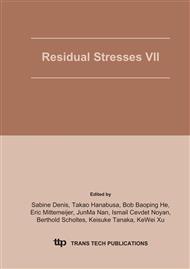p.165
p.171
p.177
p.183
p.184
p.190
p.196
p.202
p.208
Ultrasonic Evaluation of Compressive Residual Stress of Surface Treated Metals
Abstract:
Shot peening is an effective method of improving fatigue performance of machine parts in the industry by producing a thin surface layer of compressive residual stresses that prevents crack initiation and retards crack growth during service. Nondestructive evaluation of the prevailing compressive residual stresses in the shallow subsurface layer is realized by the critically refracted longitudinal (Lcr) waves. This paper presents experimental data obtained on SMAT (surface mechanical attrition treatment) steel alloy S355 sample. Comparative travel-time shows that there are statistically significant differences in treated and untreated specimen. With knowledge of the acoustoelastic constants which are obtained by a test calibration, the experimental data indicates that compressive residual stresses are distributed near subsurface (hundreds of micron). These stress results show that the Lcr technique is efficient for evaluation of residual stresses after the surface treatment.
Info:
Periodical:
Pages:
184-189
Citation:
Online since:
July 2005
Authors:
Price:
Сopyright:
© 2005 Trans Tech Publications Ltd. All Rights Reserved
Share:
Citation:


